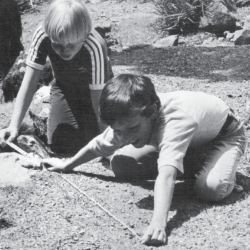Source Institutions
Source Institutions
Add to list Go to activity
Activity link broken? See if it's at the internet archive

In this outdoor activity/game, learners use thermometers to simulate how lizards survive in habitats with extreme temperatures. Learners are challenged to keep their thermometer-lizard "alive" by keeping its temperature within a five-degree safe range. While regulating their pretend lizards' temperatures, learners must move the lizards through a course of sun and shade, trying to reach the finish first. Through the game and followup discussion, learners come to understand different ways that exotherms, or "cold-blooded" animals, regulate their body temperatures and how they differ from endotherms, or "warm-blooded" animals, such as humans. Activity must be done on a warm, sunny day in a site with areas of deep shade, bright sun, and broken or partial shade.
- 30 to 45 minutes
- 45 to 60 minutes
- $5 - $10 per group of students
- Ages 8 - 18
- Activity, Game, Lesson/Lesson Plan, Simulation
- English
Quick Guide
Materials List (per group of students)
- Celsius thermometers
- one-meter lengths of string
- flagging on small sticks or dowels
- masking tape
- watch with second hand
- 8-meter length or rope or string
Subjects
-
Earth and Space Science
-
Earth Processes
- Weather and Climate
-
Earth Processes
-
Life Sciences
-
Diversity of Life
- Animals
-
Ecology
- Ecosystems
- Populations
-
Evolution
- Evidence for Evolution
- Human Body
-
Diversity of Life
-
Mathematics
-
Data Analysis and Probability
- Data Analysis
- Data Collection
-
Measurement
- Units of Measurement
- Rate
-
Number and Operations
- Operations
-
Data Analysis and Probability
-
Physical Sciences
-
Heat and Thermodynamics
- Heat and Temperature
-
Heat and Thermodynamics
-
The Nature of Science
-
The Scientific Process
- About Inquiry
- Asking Questions
- Conducting Investigations
- Gathering Data
- Formulating Explanations
- Communicating Results
-
The Scientific Process
Informal Categories
- Animals
- Games
- Nature and Environment
- Outdoor Activity
Audience
To use this activity, learners need to:
- see
- read
- be mobile
- touch
Learning styles supported:
- Involves teamwork and communication skills
- Involves hands-on or lab activities
Other
This resource is part of:
Access Rights:
- Free access
By:
Rights:
- All rights reserved, The Regents of the University of California, 1980
